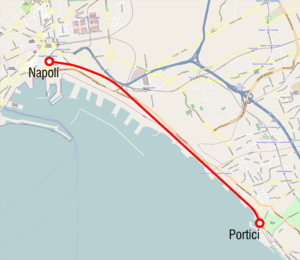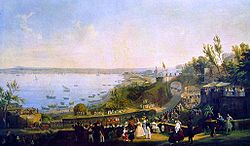- Naples–Portici railway
-
The Napoli-Portici was the first Italian railway line; it was built by the Bayard Company and opened in 1839. It now forms part of the Naples–Salerno line.
Geography
The initial line was a double track of 7.25 kilometres (4.5 mi). It ran from the current site of Corso Garibaldi in Naples to the royal palace at Portici, at the foot of Mount Vesuvius, now used by the Faculty of Agriculture of the University of Naples Federico II.
History
The line was promoted by a French man, Armand Bayard de la Vingtrie, who received a concession to build it in February 1837 from King Ferdinand II of the Two Sicilies. The concession authorised Bayard to build a railway from the current location of Napoli Centrale station outside the old walls of Naples along the Bay of Naples to Nocera Inferiore on the Sorrentine Peninsula, a distance of 35.8 kilometres (22.2 mi), with possible extensions to Salerno and Avellino, both through mountainous country. The line was built of wrought iron rails mounted on large cubic stone sunk into the ground (as the system of using wooden sleepers to distribute weights had not been invented) and gauge was maintained from time to time with transverse bars. Three locomotives were imported from Longridge and Co of England: two 2-2-2 locomotives for passenger traffic, named Bayard and Vesuvio and one locomotive for goods traffic; rollingstock was built locally. The king opened the first 7.25 kilometres (4.5 mi) of the line was from Naples to Portici on 3 October 1839. By the end of 1839 it had carried 131,116 passengers. It was extended to Castellammare di Stabia in 1842 and Nocera in 1844.[1]
References
- ^ Kalla-Bishop, P. M. (1971). Italian Railways. Newton Abbott, Devon, England: David & Charles. pp. 15–16.

This article about transport in Italy is a stub. You can help Wikipedia by expanding it.


